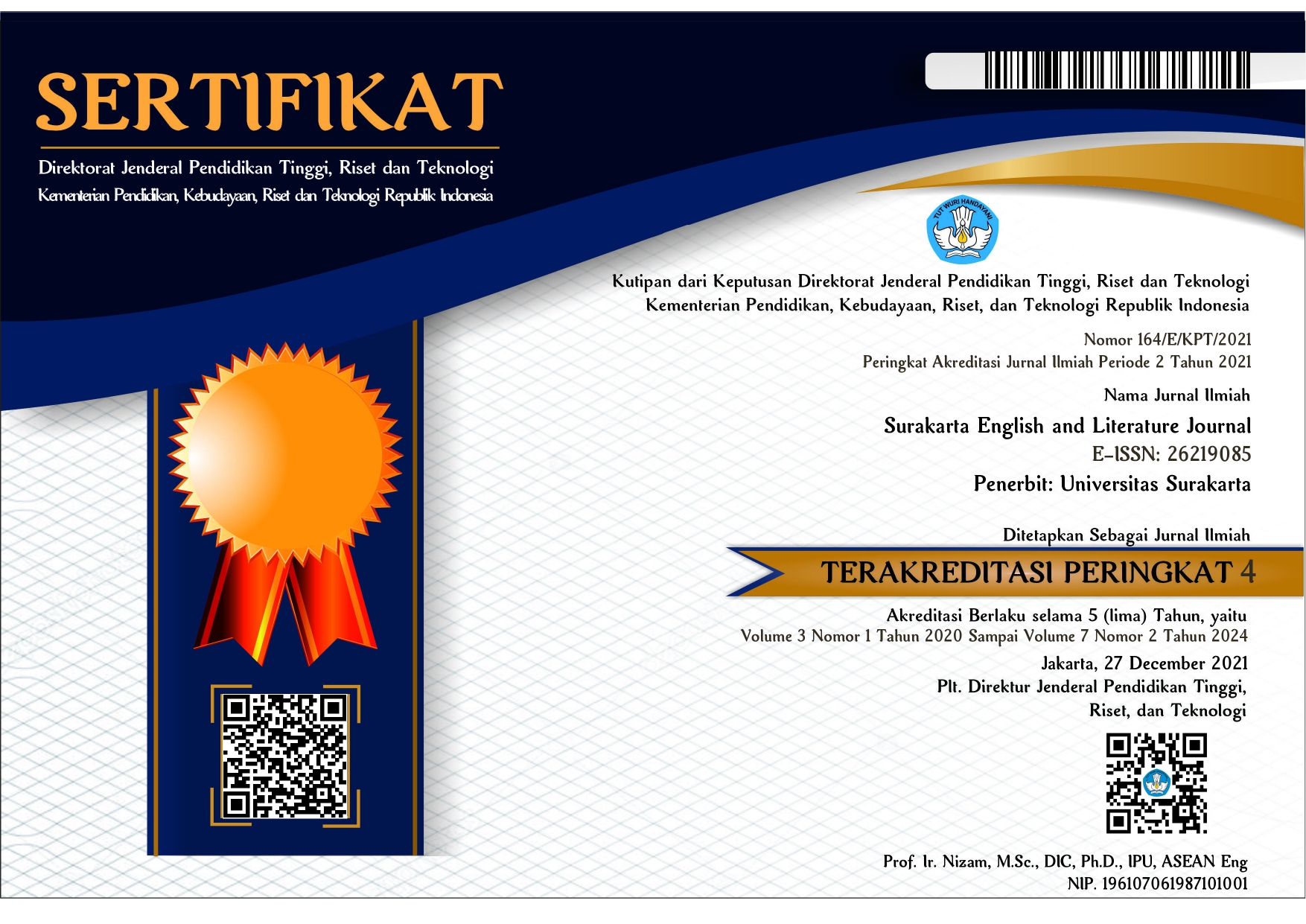Hidden Desires and Social Norms in 'Young Goodman Brown': A Psychoanalytic Analysis
DOI:
https://doi.org/10.52429/selju.v7i2.263Keywords:
psychoanalysis, hidden desires, social norms, anxiety, fearsAbstract
Literature has provided a deep understanding of the human psyche and behavior. “Young Goodman Brown” by Nathaniel Hawthorne is a literary work exploring the psychological component. This study attempts to discover the conflict between hidden desires and social norms and the anxieties and fears from a psychoanalysis point of view. This study uses qualitative descriptive techniques to delve into the context. In addition, this study uses Freudian Psychoanalytic which are Id, Ego, and Superego. The research contributes to the broader field of literary analysis related to psychoanalytic theory, facilitating a deeper understanding of the story by revealing the character’s actions. By focusing on the protagonist’s personality traits, readers are expected to gain a comprehensive understanding of the story's central conflict. This study is intended to engage scholars, researchers, and students in the interpretive analysis of this short story.
References
Abood, A. (2018). A Study of Modality and Point of View in One Selected Short Stories.
Adwas, A. A., Jbireal, J. M., & Azab, A. E. (2019). Anxiety: Insight into Signs, Symptoms, Etiology, Pathophysiology, and Treatment. East African Scholars Journal of Medical Sciences, 2(10).
Anxiety Centre. (2024). Anxiety Symptoms and Signs - Over 100 Listed. http://www.anxi-etycentre.com/anxiety-symptoms.shtml
Asuncion, J., Bautista, K. C., Sumalde, H. G., & Cadanova, A. S. (2023). Traversing the Psychoanalytical Realm of the Sadness Collector by Merlinda Bobis: the Interaction and Conflicts among the Characters’ Id, Ego, and Superego.
Bicchieri, C., Muldoon, R., & Sontuoso, A. (2018). Social Norms. In Stanford Encyclopedia of Philosophy. Stanford.
Daneshzadeh, A. (2015). Analysis of James Joyce's Short Stories. International Letters of Social and Humanistic Sciences.
Dashela, T. (2021). The Analysis of Theme and Rheme in Short Story of Sleeping Beauty with a Systematic Functional Approach. Study of Applied Linguistics and English Education (SALEE), 2(1).
De, I., Singh, S., & Panda, S. S. (2021). Understanding Social Norms. In Gender and Collective Behaviour, Development Paradigms in India. https://doi.org/DOI: 10.1007/978-981-16-6952-1_2
Dein, S. (2010). Religion, Spirituality, and Mental Health.
Dictionary, C. E. (2024). Anxiety Meaning in the Cambridge English Dictionary. https://dictionary.cambridge.org/dictionary/english/anxiety
Dodhy, S. (2017). Fear—A Positive Potential: Classic Explanation And New Elucidation. New Academia: An International Journal of English Language, Literature and Literary Theory, VI(I).
Eagleton, T. (2008). The Meaning of Life: A Short Introduction. Oxford University Press.
Fauzan, U. (2016). Structural Analysis of “Peanut & Sparky”: A Short Story by Arnie Lightning as A Way in Understanding Literature.
Freud, S. (1923). The Ego and The Id (Standard E). Hogarth Press.
Freud, S. (1933). New Introductory Lectures on Psychoanalysis (J. Strachey (ed.); Standard E). W. W. Norton & Company.
Frye, N. (1957). Anatomy of Criticism: Four Essays. Princeton University Press.
Gomez, L. (1997). An Introduction to Object Relations. Free Association Books.
Hidayah, A. (2019). A Deixis Analysis of Song Lyrics in Back to You by Selena Gomes. Surakarta English and Literature Journal (SELJU), 2(2).
Irawan, D. (2015). Structural Analysis of Plot in Rick Riordan’s “Percy Jackson and The Olympians: The Lightning Thief.”
Jung, C. G. (1912). Psychology of the Unconscious. Dover Publications.
Kharbutly, M., & Omoush, I. (2021). Socio-Psychological Alienation in Nathaniel Hawthorne’s “Young Goodman Brown.” Asian Social Science, 17(1).
Kristoff, D. (2014). Nathaniel Hawthorne’s Young Goodman Brown.
Latif, M. M. (2016). An Analysis of Characterization of the Main Characters in “The Social Network” Movie Script.
Milne, R., & Munro, M. (2020). Symptoms and Causes of Anxiety, and Its Diagnosis and Management. Nursing Times Online, 116(10), 18–22.
Nurhandayani, K. (2014). An Analysis of Themes and Sub-themes in Judy Blume’s Are You There God? It’s Me, Margaret. Yogyakarta State University.
Parui, D., & Avishek, S. (2019). American Short Story: An Introduction to its Emergence and Development. Avenel Press.
Sharma, A. (2020). Sigmund Freud’s Psychoanalysis Theory of Personality.
Sibi, K. J. (2020). Sigmund Freud and Psychoanalytic Theory. LangLit An International Peer-Reviewed Open Access Journal.
Tiana, K. S. (2015). An Analysis of Characterization in The Diary of Ma Yan.
Wellek, R., & Warren, A. (1948). Theory of Literature. Harcourt, Brace, and Company.
Xi, Y. (2020). Anxiety: A Concept Analysis. Frontiers of Nursing, 7(1). https://doi.org/10.2478/FON-2020-0008
Xiaokang, W. (2021). Narratological and Stylistic Analysis of Point of View in Faulkner’s “A Rose for Emily.” English Language, Literature & Culture, 6(3), 91–96.
Yu, X. (2022). Hidden Desires: A Unified Strategy for Defending the Desire-Satisfaction Theory. Utilitas (Cambridge University Press), 1–16. https://doi.org/doi:10.1017/S0953820822000309
Zhang, S. (2020). Psychoanalysis: The Influence of Freud’s Theory in Personality Psychology. Advances in Social Sciences, Education and Humanities Research.
Downloads
Published
How to Cite
Issue
Section
License
Copyright (c) 2024 Salsabila Rizqi Sanina Amisar, Teguh Kasprabowo

This work is licensed under a Creative Commons Attribution-ShareAlike 4.0 International License.
Licensing for Data Publication
-
Open Data Commons Attribution License, http://www.opendatacommons.org/licenses/by/1.0/ (default)
-
Creative Commons CC-Zero Waiver, http://creativecommons.org/publicdomain/zero/1.0/
-
Open Data Commons Public Domain Dedication and Licence, http://www.opendatacommons.org/licenses/pddl/1-0/














